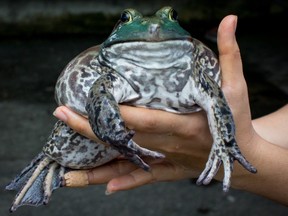
Article content
OTTAWA — It’s a story that’s making government watchdog groups hopping mad.
Advertisement 2
Article content
Just months after documents uncovered details of Parks Canada’s multi-million deer cull in the B.C. coastal islands, newly-released documents reveal the government agency spent four years and $10,000 just to kill one bullfrog.
Uncovered Thursday by the Canadian Taxpayers Federation, the documents outlined a costly initiative to eliminate invasive American Bullfrog populations in Gulf Island National Park on the southern coast of British Columbia — which only managed to cull a total of one frog.
“Parks Canada is horrible at hunting, but they sure seem great at wasting our money trying,” said the federation’s B.C. Director Carson Binda.
According to the documents, Parks Canada spent $1,920 in the 2018-19 fiscal year on the hunt, of which the bullfrog population emerged unscathed.
Article content
Advertisement 3
Article content
That was followed by a $2,000 effort the following years, which likewise resulted in removing zero frogs from the park.
After a brief pandemic-related hiatus, the Parks Canada bullfrog hunters were once again on the prowl, spending $2,207 to kill precisely no frogs.
But it wasn’t until 2022-23 that the program started to bear results, spending $3,882 to eliminate a single frog from the island.
RECOMMENDED VIDEO
Clearly catching their stride, the program managed to kill 100 of the frogs in the 2023-24 fiscal year, at a cost of $5,079.
In all, it cost Parks Canada $15,088 to croak 101 frogs — and a little over $10,000 and four years to garner the program’s first kill.
According to the Invasive Species Council of B.C., the American Bullfrog is an invasive species in the province, their native habitats consisting of wetlands in eastern North America.
Advertisement 4
Article content
Initially introduced to support a frog leg farming industry, the aquatic amphibians escaped and established large populations throughout B.C.’s lower mainland, Vancouver Island and the Kootenays.
Growing upwards of 20 centimetres in length, the frogs have an appetite to match their body — eating anything capable of fitting inside its large mouth, including native frogs, small turtles, rodents and even garter snakes.
Recommended from Editorial
Earlier this year, it was revealed that Parks Canada paid $12 million to hire foreign sharpshooters to cull an invasive herd of European fallow deer from Sidney Island on the B.C. coast, which only managed to kill 84 deer last year.
That’s nearly double the initial estimates, and ignores efforts by local hunters — who managed to harvest 2,000 of the animals at no cost to taxpayers.
“If this was a one-off, if them spending $10,000 to kill one frog was the only wildly-unsuccessful cull that they’ve managed, that would be one thing,” Binda said.
“But the Sidney Island deer cull is another great example of Parks Canada wasting a ton of taxpayer money for really dodgy results.”
Article content


